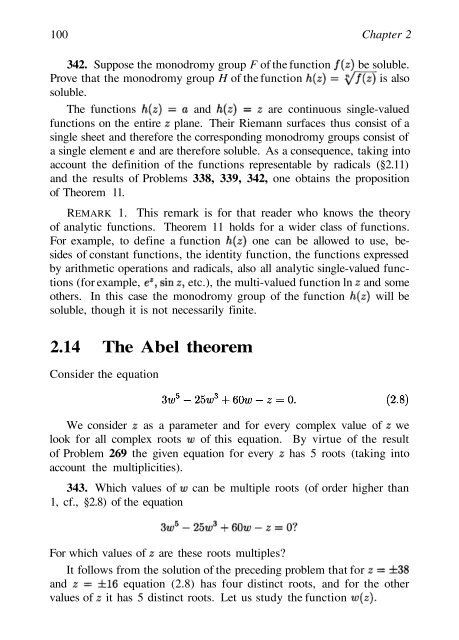Abel's theorem in problems and solutions - School of Mathematics
Abel's theorem in problems and solutions - School of Mathematics
Abel's theorem in problems and solutions - School of Mathematics
Create successful ePaper yourself
Turn your PDF publications into a flip-book with our unique Google optimized e-Paper software.
100 Chapter 2<br />
342. Suppose the monodromy group F <strong>of</strong> the function be soluble.<br />
Prove that the monodromy group H <strong>of</strong> the function is also<br />
soluble.<br />
The functions <strong>and</strong> are cont<strong>in</strong>uous s<strong>in</strong>gle-valued<br />
functions on the entire plane. Their Riemann surfaces thus consist <strong>of</strong> a<br />
s<strong>in</strong>gle sheet <strong>and</strong> therefore the correspond<strong>in</strong>g monodromy groups consist <strong>of</strong><br />
a s<strong>in</strong>gle element <strong>and</strong> are therefore soluble. As a consequence, tak<strong>in</strong>g <strong>in</strong>to<br />
account the def<strong>in</strong>ition <strong>of</strong> the functions representable by radicals (§2.11)<br />
<strong>and</strong> the results <strong>of</strong> Problems 338, 339, 342, one obta<strong>in</strong>s the proposition<br />
<strong>of</strong> Theorem 11.<br />
REMARK 1. This remark is for that reader who knows the theory<br />
<strong>of</strong> analytic functions. Theorem 11 holds for a wider class <strong>of</strong> functions.<br />
For example, to def<strong>in</strong>e a function one can be allowed to use, besides<br />
<strong>of</strong> constant functions, the identity function, the functions expressed<br />
by arithmetic operations <strong>and</strong> radicals, also all analytic s<strong>in</strong>gle-valued functions<br />
(for example, etc.), the multi-valued function ln <strong>and</strong> some<br />
others. In this case the monodromy group <strong>of</strong> the function will be<br />
soluble, though it is not necessarily f<strong>in</strong>ite.<br />
2.14 The Abel <strong>theorem</strong><br />
Consider the equation<br />
We consider as a parameter <strong>and</strong> for every complex value <strong>of</strong> we<br />
look for all complex roots <strong>of</strong> this equation. By virtue <strong>of</strong> the result<br />
<strong>of</strong> Problem 269 the given equation for every has 5 roots (tak<strong>in</strong>g <strong>in</strong>to<br />
account the multiplicities).<br />
343. Which values <strong>of</strong> can be multiple roots (<strong>of</strong> order higher than<br />
1, cf., §2.8) <strong>of</strong> the equation<br />
For which values <strong>of</strong> are these roots multiples?<br />
It follows from the solution <strong>of</strong> the preced<strong>in</strong>g problem that for<br />
<strong>and</strong> equation (2.8) has four dist<strong>in</strong>ct roots, <strong>and</strong> for the other<br />
values <strong>of</strong> it has 5 dist<strong>in</strong>ct roots. Let us study the function

















